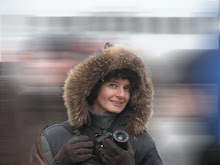Cover Art for Legacy Works: It's Not Window Dressing
Linda Coffin knows one thing, and that is that narrative and design “simply must go hand-in-hand if we want to do justice to the story.” In a recent thread on The Association of Personal Historians listserv, Linda (founder of the full service company HistoryCrafters) articulates what many people in the life story industry feel about the relationship between good information design, rich imagery, good story-telling and emotion.
Linda writes:
Linda goes on to say:“There are many compelling and well-written stories that go unread simply because they look amateurish or even downright bad. Too often design is treated as just window-dressing (as in "this isn't about a pretty design - it's about the story!"). Well, of course the story is the center of the whole thing. But most people are unaware of how much a good design can be a vital communication tool, telling its own story about the narrative and the narrator.”
“A case in point: my client's family was unhappy with his narrative, telling him that he hadn't put enough emotion into it and that it was boring to read. But now that I've redesigned the layout and given them a sample of the first chapter, the narrative flows in a clearly readable form. The photos are now sharp and crisp and sitting next to the text they illustrate. The chapter and topic divisions make sense. The headers and footers are correct and help guide you through the story. Guess what? Suddenly his family is thrilled. "Wow, Dad, this is great stuff," said the same son who earlier had complained that there was no emotion in his story. Same client, same material, same story, but much better design and production.”
High production values and original cover go hand-in-hand
What we're talking about is professional production values:
- Chapters laid out like a good film, whether it runs linearly, in flashbacks or uses some other dramatic device
- Clear headers and footers; the equivalent of website “breadcrumbs” which show the reader where they came from and where they’re headed
- High resolution images (e.g. photographs and documents)with captions that correlate with the text and serve as self-guided tours, pointing out extraordinary visual details and back stories otherwise missed
But there is yet another significant metamorphosis that professionally conceived life stories should undergo - a vital step that can make all the difference in the world. It is adding the line-item of original artwork for the cover of your legacy work (and, if budget allows, chapter art as well). Why artwork for the cover, versus just selecting one compelling photograph from your archives? Because art sends out the single most important message about our hero/heroine: it encapsulates the point-of-it-all. It communicates the meaning of the subject’s life and the point of the narrative directly into our right brains. And it accomplishes this complex story-telling, among many other things, with the medium's sensual expression of feeling, and the artist's intentional use of atmosphere, subject matter and props.
What kind of artwork is right for the cover of your legacy book, CD or DVD?
When it comes to recommending what imagery should become the “face” of your legacy project, your best bet is to defer to the project’s Creative Point Person. They may be, as in Linda Coffin's case, wearing multiple hats (as graphic designer and book editor, for example.) Their talent is knowing the importance of future generations seeing a “likeness” in the face or landscape on the cover. So they will be on the lookout from the beginning for visual imagery that subconsciously telegraphs the kind of people portrayed in your legacy work. Whether it should be a digitally-enhanced photograph, a photo-realistic painting, a mixed media photo collage or even a surrealistic photomontage with whimsical objects will come down, in the end, to what best communicates the psychological “point-of-it-all.”
Most likely the Point Person will have touched every archival photograph in the possession of the family from the very beginning of the project. They will have been in the client’s home, and seen photographic portraits or paintings on the wall. They will have been the first to learn whether the subject had artistic proclivities in the “early years” (i.e. watercolors made in high school or a sketch on a napkin), or if the subject is still making art, they may be the very person to urge the subject to create a self-portrait for the cover. If a talented family member volunteers to create original artwork for the project, they will know right away whether this is a brilliant idea, or not.
As a curator and full service graphic designer, professionals like Linda Coffin have an excellent sense of what kind of imagery belongs on the cover, because they have been living and breathing the “point-of-it-all” for months. They have edited the text and laid out the content in the most logical and entertaining manner possible. If it’s fitting, they may recommend that haunting photograph of the subject before (or after) a catastrophic event. If no truly striking photographs exist, they may recommend a mixed media piece that transforms a so-so photograph into a Renaissance portrait, complete with meaningful objects set in a backdrop that divulges the subject’s status, profession and even cause célèbre.
Ultimately, what you are paying for is your Point Person's heightened sense of objectivity. That "distance" from the project is precious because it enables them to pick up on the big patterns or themes behind a life review and bring the best one front and center.
So what are the proven winners in terms of cover art?
From the family:
- Self-portraits: in any medium, executed at any age, by the subject (or) a family member
- Mixed media or photo collage work, combining multiple still photographs and artwork, by hand
From a professional artist, commissioned work, such as:
- Portrait of the subject, at any age, in any medium (even a sculpture can be photographed and used as an image)
Fig.1. The Journey of Henry Kagan. Artist: Lisa Kagan |
- Photo collage or mixed media combining archival photographs, stills from archival film/video, with or without artwork (Fig. 2. Mixed media with one photo by Lisa Kagan of Family Heirloom Arts)
Fig. 2. Tolya Serving His Country Artist: Nancy Gershman |
- Digital fine art photomontage, seamlessly combining imagery from multiple archival or heritage vacation photographs together into a single scene, augmented by meaningful objects, clothing and accessories or landscapes researched and supplied by the digital artist (Fig. 2. Photomontage created from four photos by digital artist Nancy Gershman of Art For Your Sake)
The effect is pure theatre, not just for the first generation of readers, but generations to come. And that's why who you choose to package your legacy makes all the difference in the world.
Nancy Gershman of Art For Your Sake is a digital artist specializing in fine art legacy portraiture for gifts and personal histories. As a post-therapy resource, Gershman also creates prescriptive photomontages for healing (bereavement, acceptance, relationship rifts and addictive behaviors) to counter loss and regrets.




No comments:
Post a Comment